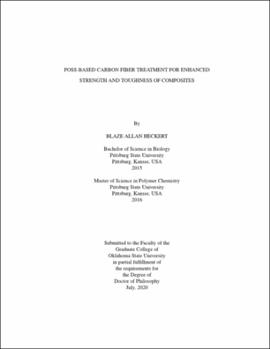| dc.contributor.advisor | Singh, Raman P. | |
| dc.contributor.author | Heckert, Blaze Allan | |
| dc.date.accessioned | 2021-11-29T21:46:27Z | |
| dc.date.available | 2021-11-29T21:46:27Z | |
| dc.date.issued | 2020-07 | |
| dc.identifier.uri | https://hdl.handle.net/11244/331281 | |
| dc.description.abstract | In this study, two techniques are used to coat carbon fibers with polyhedral oligomeric silsesquioxane (POSS) as a fiber surface treatment. This process utilizes the unique organic--inorganic hybrid structure of POSS to develop damage--tolerant composite laminates. This paper compares POSS-based treatments based on two different approaches. A more traditional approach via esterification reaction and a novel approach utilizing thiol-ene click chemistry. Click chemistry reactions achieve very high yields and are performed in a variety of solvents. | |
| dc.description.abstract | The treated carbon fibers are analyzed using XPS and SEM. The modified POSS used in the first approach is characterized using NMR and FT-IR. Single fiber tensile tests of the first approach show a significant decrease in the fiber tensile strength, while the second approach showed no loss in fiber strength. Interfacial shear strength is determined using single-fiber fragmentation testing. The first approach showed a decrease of 24% in the fiber fragmentation length compared to the as-received fibers, however because of the loss in fiber strength there is a decrease of 6% in the interfacial shear strength compared to the as-received carbon fibers. The second approach, however, shows a 27% decrease in the fiber fragment length compared to the as-received fibers, and as a result has an 71% increase in the interfacial shear strength as compared to the as-received carbon fibers and a ~80% increase compared to the first approach. | |
| dc.description.abstract | There has been recent interest in the use of multilayer POSS to further enhance the interfacial properties of the composite. However, this comes with the challenge of POSS--POSS agglomeration that will result in nonuniform distribution of properties across the fiber surface. There has been no attempt to control the POSS--POSS, nor to examine how the compliance will be altered by additional layers of POSS. To better understand how additional POSS layers can alter the compliance of the interface, different POSS networks were synthesized using hexane-1,6-dithiol as a linking molecule and thiol-ene click chemistry. These networks varied by POSS density using different ratios of the dithiol linker molecule. The properties of these networks were analyzed using SEM and XRF. | |
| dc.format | application/pdf | |
| dc.language | en_US | |
| dc.rights | Copyright is held by the author who has granted the Oklahoma State University Library the non-exclusive right to share this material in its institutional repository. Contact Digital Library Services at lib-dls@okstate.edu or 405-744-9161 for the permission policy on the use, reproduction or distribution of this material. | |
| dc.title | POSS-based carbon fiber treatment for enhanced strength and toughness of composites | |
| dc.contributor.committeeMember | Smay, James E. | |
| dc.contributor.committeeMember | Vaidyanathan, K. Ranji | |
| dc.contributor.committeeMember | Sallam, Khaled A. | |
| osu.filename | Heckert_okstate_0664D_16901.pdf | |
| osu.accesstype | Open Access | |
| dc.type.genre | Dissertation | |
| dc.type.material | Text | |
| thesis.degree.discipline | Materials Science and Engineering | |
| thesis.degree.grantor | Oklahoma State University | |
